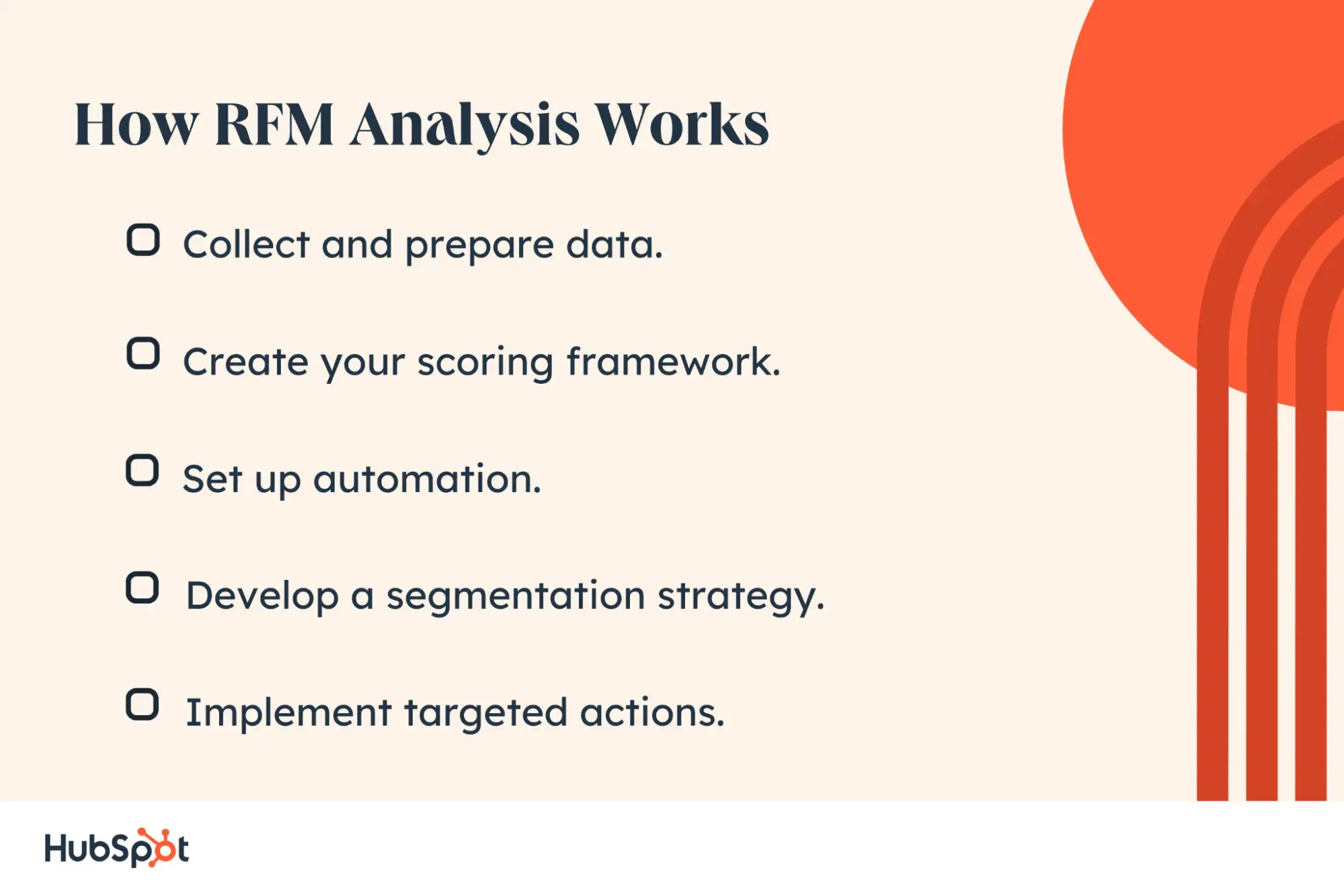Analyzing these data points can give you a fuller picture of your customer base, so let’s dig into what RFM means, why it matters, and how to conduct an RFM analysis.
In this article:
RFM
RFM is a strategy for analyzing and estimating the value of a customer, based on three data points: Recency (How recently did the customer make a purchase?), Frequency (How often do they purchase), and Monetary Value (How much do they spend?).
- Recency. How recently did the customer make a purchase? If they made a purchase recently, they are likely to make another purchase. However, if the customer hasn’t made a purchase in a while, you may need to nurture them with new promotional offers or even reintroduce your brand.
- Frequency. How often does the customer make purchases? If they purchase frequently, you’ll know their spending habits and preferences, but if they make one purchase and never return, they could be a good candidate for a customer satisfaction survey.
- Monetary Value. How much do your customers spend per purchase? Don’t get too caught up on the number here — all purchases are valuable. However, the first two letters in the RFM acronym can be visualized more clearly by this third component. If they’ve made many recent purchases at a high price point, you’ve got a returning customer who can turn into a brand loyalist.
You can use these three factors of the RFM model to reasonably predict how likely (or unlikely) it is that a customer will re-purchase from a company.
What is RFM analysis?
An RFM analysis evaluates which customers are of highest and lowest value to an organization based on purchase recency, frequency, and monetary value, to reasonably predict which customers are more likely to make purchases again in the future.
How RFM Analysis Works

On the surface, RFM analysis might seem pretty straightforward — just apply the metrics, and you’ll get results. But like any good strategy, the magic is in the details. Executing an RFM analysis takes a deeper dive. Let’s break down each step.
Pro tip: While RFM analysis can transform your customer relationships, you need to pay close attention to data privacy. With 75% of consumers considering data privacy a human right, it’s vital to implement RFM analysis responsibly.
Step 1: Collect and prepare data.
Start by gathering and preparing the right customer data. In my research, I’ve discovered that this foundational step often makes or breaks the entire analysis. As Ani Ghazaryan, Head of Content & Marketing at Neptune.AI, a platform that helps machine learning teams manage and track their experiments more effectively, told me, “Getting clean, consistent data required significant upfront effort, especially as customer data was scattered across multiple systems.”
Successful RFM analysis starts with collecting essential data points, such as:
- Purchase dates for each customer.
- Number of purchases per customer.
- Total spend per customer.
- Customer identifiers (e.g., email, customer ID).
Cache Merrill, Chief Product Officer at Zibtek, a custom software development company that helps startups to Fortune 500 businesses build tailored software solutions, shared his technical approach:
“We combine several tools specific to the client’s data and CRM requirements. Some of the core tools include SQL-based data lounge for data management, custom scripts for threshold analysis, and visualization tools for assessing the performance of segments like Power BI or Tableau.”
Pro tip: According to Twilio’s research, only 51% of consumers trust brands with data security. Start with solid privacy practices and data governance to build that oh-so-integral trust.
Step 2: Create your scoring framework.
Before you start scoring customers, you need to set a framework that makes sense for your business model. This means defining what “recent,” “frequent,” and “high-value” mean in your context. “We determine these predominantly based on the data distribution, most often by quantile splitting each RFM parameter for upper and lower-tier clients,” Merrill explains. “For example, the top 25% in Recency would get the highest score in that category, and so on.”
Key decisions include:
- Scoring scale (typically 1-5 for each component).
- Periods for recency.
- Purchase frequency thresholds.
- Monetary value ranges.
Pro tip: Ronan Walsh, Managing Director of Digital Trawler, a B2B SaaS digital marketing agency, recommends having at least six to 12 months of customer data to establish meaningful scoring thresholds.
Step 3: Set up automation.
Modern RFM analysis isn’t a one-time manual process — it needs to be dynamic and automated. At Neptune.AI, Ghazaryan’s team found success by integrating their analysis with their existing tech stack: “We used Python for analysis and visualization, which allowed us to really dig into the patterns of customer behavior.”
Automation should handle daily score updates, segment transitions, communications triggers, and performance tracking. This ongoing process keeps RFM analysis fresh and in tune with the latest customer behavior, allowing businesses to quickly adjust to any shift that comes up.
Pro tip: According to HubSpot’s research, 76% of consumers are concerned with how companies use their personal data. Make sure your automated systems support privacy compliance.
Step 4: Develop a segmentation strategy.
In my interviews with industry experts, I’ve found that successful segmentation isn’t just about grouping numbers — it’s about understanding customer behavior patterns. With your scoring framework and automation in place, it’s time to create meaningful customer segments. Walsh’s team at Digital Trawler achieved a 15% increase in customer retention by “identifying those with a high likelihood of churning and proactively targeting them.”
Common segments include:
- VIP customers (high scores across all categories).
- At-risk customers (declining recency scores).
- Lost customers (low scores across the board).
- Potential loyalists (high recency but lower frequency).
Pro tip: Neptune.AI’s team succeeded by “recalibrating scoring to reflect both revenue and activity level so that we didn’t overlook loyal users in lower tiers.”
Step 5: Implement targeted actions.
The final step is turning your analysis into action. Making targeted moves based on your analysis can help you spend your marketing budget more wisely, use customer service resources better, create promotions that really hit home, and take full advantage of automation. It’s a good idea to regularly check in on your segmentation criteria to ensure your strategies keep up with what customers want and need.
Pro tip: Walsh achieved the best results by personalizing offers based on recent engagement data, which helped move customers to premium tiers.
Benefits of RFM
You might be thinking, “This sounds like a lot of work.” And you’re right — it is. But in my conversations with experts and analysis of real implementations, I’ve discovered that while setting up RFM takes some initial effort, the clarity and insights it provides make you wonder how you ever made marketing decisions without it. Let’s explore these benefits, backed by data and expert insights.
1. Increased Revenue and ROI
The most compelling benefit I’ve found is the direct impact on revenue. When done right, RFM analysis helps you target the right customers with the right offers at the right time. In a recent episode of the “Send It” podcast about retention marketing, Jimmy Kim, CEO of Royal Prospect and retention marketing expert, highlights a common mistake: treating all customers the same regardless of their spending patterns.
“Why am I sending the same offers to a $20 customer that I would give my $100 customer?” he asks. This targeted approach pays off. According to Twilio’s research, businesses report that customers spend 38% more on average when their experience is personalized through proper segmentation.
Merrill shared that his team boosted campaign performance by 25% in just three months by using RFM analysis to effectively target high-value customer segments.
Pro tip: I’ve learned from the experts that starting with your highest-value segments first often provides the quickest ROI.
2. Higher Customer Retention
RFM analysis is particularly effective for keeping valuable customers from slipping away. As Kim explains, building loyalty with frequent buyers by recognizing their continued purchases and rewarding them with targeted offers can significantly enhance customer relationships and boost retention.
Ghazaryan’s team at Neptune.AI saw a 15% reduction in churn by identifying and proactively engaging with at-risk customers before they left.
Pro tip: Use RFM scores as an early warning system. Declining scores often signal churn risk before other metrics show problems.
3. More Effective Marketing Campaigns
One benefit that surprised me was how much more efficient marketing becomes with RFM insights. “After segmenting based on RFM scores, our engagement rates jumped by over 20%,” Ghazaryan told me, particularly in their high-recency, high-frequency customer group.
RFM analysis enables more targeted messaging, better timing of communications, more relevant offers, and reduced marketing waste.
Pro tip: Test your RFM-based campaigns against your regular campaigns to see where to focus your efforts.
4. Enhanced Customer Experience
In today’s market, I’ve found that personalization isn’t just nice to have — it’s expected. Salesforce’s research shows that 73% of customers expect companies to understand their unique needs and expectations. RFM analysis helps deliver on this expectation.
Interestingly, 56% of consumers become repeat buyers after receiving personalized experiences. Better customer understanding leads directly to better business results.
Pro tip: Use RFM insights to adjust not just your marketing but also your customer service approach. High-value customers often warrant premium support options.
5. Better Resource Allocation
Finally, I’ve discovered that RFM analysis helps businesses make smarter decisions about where to invest their time and resources. Merrill’s team reviews the segmentation criteria every quarter to better target customers as their behavior changes, ensuring their efforts focus on the most promising opportunities.
Allocating resources more effectively means optimizing marketing spend, enhancing customer service efforts, targeting promotions more precisely, and leveraging automation where it makes the most sense. Regularly tracking segment responses to different investments allows for continuous refinement and better overall efficiency.
Pro tip: Track which segments respond best to different types of investments and continually refine your resource allocation.
How to Calculate RFM
Step 1: RFM Scoring
Start by classifying customers by a numerical ranking for each category: recency, frequency, and monetary value. The ideal customer earns the highest score in each of these categories. This scoring is crucial to determine which customers are most valuable.
For example, you might evaluate recency on a scale of 1-5, with a score of 5 meaning the customer made a purchase within the last month, while a score of 1 means their last purchase was over a year ago. RFM scoring helps businesses pinpoint and prioritize high-value customers to target.
Step 2: Run an RFM analysis.
Once each customer has been assigned a score for each category, you can calculate the combined RFM score by summing the individual values for Recency, Frequency, and Monetary. This combined score allows you to segment customers into groups based on their likelihood of making future purchases.
Step 3: Crystalize customer communications.
RFM analysis offers a snapshot of which customers have purchased most recently, most often, and spent the most money. However, it’s important not to bombard high-score customers with too many offers. Instead, use their high RFM score to learn about their preferences and fine-tune your approach.
Pro tip: High RFM scores should serve as a guide for deepening relationships — focus on learning from these customers and enhancing their experience rather than overwhelming them with sales pitches.
RFM Analysis Example
To better understand RFM, I’ll walk us through an example of how RFM analysis can be applied in practice. Let’s say I’m running an ecommerce store called Ruff Riders that sells dog supplies and accessories. Here’s how I would use RFM analysis to better understand Ruff Riders’ customers.
Step 1: Gathering Data
I’ll collect a year’s worth of customer purchase data, including customer IDs, purchase dates, order values, and the number of orders per customer. I can use a simple spreadsheet for this analysis or a more sophisticated tool like a customer data platform or CRM system. Data accuracy is critical here — any inconsistencies would directly impact the analysis results, so I need to get this step right.
Step 2: Calculating RFM Scores
Next, I’ll score each customer based on Recency, Frequency, and Monetary value, using a scale from 1 to 5:
- Recency. Customers who purchased within the last 30 days scored a 5, while those who purchased over 180 days ago scored a 1.
- Frequency. Customers who made 12 or more purchases in a year scored a 5, while those with just one purchase received a score of 1.
- Monetary Value. Customers who spent over $500 scored a 5, while those spending less than $50 scored a 1.
Assigning these scores allows me to generate an overall RFM score for each customer, which helps determine who my high-value customers are and who needs more attention.
Step 3: Identifying Key Segments
With the RFM scores calculated, I can segment customers into different groups:
- Champions (555). These are the most engaged, highest-spending customers. I can focus on nurturing their loyalty through exclusive offers and early access to new products.
- Loyal Customers (4xx, 5xx). These customers buy frequently but don’t spend as much as champions. To keep them engaged, I developed loyalty programs and offered referral incentives.
- At-Risk Customers (3x1, 3x2). These customers purchased frequently in the past but haven’t made any recent purchases. I can create win-back campaigns to re-engage them with personalized offers.
Step 4: Implementing Targeted Strategies
For each segment, I’ll tailor specific strategies to drive engagement:
- Champions. I can offer early access to new products, personalized thank-you messages, and VIP customer service.
- Loyal Customers. I can launch a loyalty rewards program with discounts and special referral incentives.
- At-Risk Customers. I can send reactivation campaigns, including exclusive discounts and product promotions aligned with their previous purchases.
This hands-on RFM analysis shows the value of segmenting customers based on their buying behavior, which allowed me to focus on building stronger relationships and driving growth effectively.
Pro tip: Start simple. Initially, I tried to create too many segments, making it difficult to manage. Focusing on a few key groups that align with your capabilities is much more effective.
RFM Analysis for Customer Segmentation
Once you’ve calculated RFM scores for your customers, the fun part begins! Use these insights to create customer segments to help you tailor your marketing and customer service strategies to each group’s specific needs and behaviors.
1. Define your scoring criteria.
Start by defining your RFM scoring system based on your business model. This helps you identify the most important criteria for each customer group and ensures consistency.
2. Create customer segments.
Based on RFM scores, define key customer segments, such as:
- VIP Customers. High scores in Recency, Frequency, and Monetary value. These customers are your most valuable and should receive special perks, personalized communication, and priority support.
- At-Risk Customers. High Monetary scores but declining Recency and Frequency. These customers may need re-engagement campaigns to renew their interest and loyalty.
- New Customers. High Recency scores but lower Frequency and Monetary scores. Focus on building a strong relationship and providing onboarding support.
- Loyal Customers. High Frequency scores. Offer loyalty rewards to encourage continued engagement.
Merrill highlighted how regularly reviewing segmentation criteria helps better target customers as their behavior evolves, ensuring strategies remain effective. Ghazaryan also emphasized how recalibrating scoring helped ensure they always reflected each customer’s true value.
3. Integrate customer service strategies.
Customer service plays a big role in maintaining these relationships. For example:
- Provide VIP customers with dedicated support channels or priority service to keep them happy.
- Set up alerts for your support team to proactively reach out if at-risk customers haven’t engaged lately.
- Offer additional onboarding support to help new customers get the most value from their initial purchase.
4. Develop targeted actions.
Once segments are created, develop targeted strategies for each group. For VIP customers, consider providing exclusive offers and personalized messages to reinforce their value to your business. For at-risk customers, implement re-engagement campaigns that specifically address their needs and encourage them to reconnect with your brand.
Using these tailored approaches allows you to craft marketing and customer service strategies that resonate with each audience. This way, your efforts are more effective, leading to better retention and stronger customer relationships.
Real-World RFM Analysis Case Studies
To demonstrate the power of RFM analysis, let’s explore how four different companies transformed their customer engagement and business performance using this approach. Each story highlights unique challenges and the strategic insights that drove their success.
A SaaS company increases retention by 15%.
Ronan Walsh from Digital Trawler shared the story of a mid-sized B2B SaaS provider with around 2,000 active customers. Like many companies, they faced a pressing challenge: improving customer retention and maximizing lifetime value. Over six months, they implemented an RFM analysis strategy to tackle these goals.
The turning point was personalizing offers based on customers’ recent engagement data. By doing so, they were able to encourage customers to upgrade to premium subscription tiers, driving up their average order value (AOV) without inflating acquisition costs.
“By personalizing offers based on recent engagement data, we encouraged users to move up to premium subscription tiers, driving higher AOV,” explained Walsh. This focused strategy resulted in a 15% increase in retention and a 10% boost in AOV, illustrating how precise, data-driven actions can make a difference.
Ecommerce fashion retailer revitalizes engagement.
A fashion ecommerce brand with significant repeat purchase potential set out to deepen its connection with high-value customers and drive repeat purchases. They adopted RFM analysis for a three-month campaign designed to target their most valuable buyers.
By focusing on those who had made recent purchases, they crafted campaigns that resonated with this high-value segment. According to Cache Merrill from Zibtek, “We concentrated on high-value buyers who had made a purchase very recently. Customized RFM cutoffs helped us target segments with high revenue potential while identifying at-risk customers.”
This strategic focus led to a 25% boost in campaign performance, with noticeable gains starting within just 6-8 weeks and major successes by the end of the quarter.
Neptune.AI boosts user engagement.
Neptune.AI, a SaaS company providing tools for machine learning teams, was facing a challenge in keeping users engaged. To tackle this, they combined RFM analysis with their CRM to focus on improving user engagement.
Their success really came from creating targeted educational content and webinars for users in the “high-recency, high-frequency” group. Ani Ghazaryan mentioned that this approach allowed them to boost user engagement and cut down on churn. As a result, engagement rates shot up by 20%, churn dropped by 15%, and customer lifetime value increased by 10%.
The company also rolled out targeted reactivation campaigns to reconnect with users in the “low-recency, high-value” segment, showcasing the latest features of their platform.
Retail re-engagement campaign revives inactive customers.
A retail business was dealing with a typical issue: A bunch of customers had gone quiet and hadn’t engaged in six to 12 months. Wanting to win their customers back, the company kicked off a four-month re-engagement campaign using RFM analysis. It pinpointed 1,500 dormant customers and reached out with personalized incentives and content to spark their interest again.
The outcome was pretty impressive — 22% of those customers returned, making a tangible difference in their quarterly revenue. This scenario really highlights how important it is to get to know your customer segments well and create offers that really resonate with them.
Pro tip: While these case studies show impressive results, remember that each business requires different scoring criteria and segmentation strategies. Adapting RFM analysis to your specific business model and customer behavior patterns is key.
An RFM Analysis to Grow Your Customer Base
When I first started diving into RFM analysis, I wasn’t entirely sure what to expect. But it quickly became apparent that it’s more than just a bunch of numbers. Conducting an RFM analysis is all about figuring out how much of your revenue comes from loyal, repeat customers versus new ones and finding ways to keep those loyal customers happy. It’s about seeing where things might be falling short and how to better meet customer needs so that they keep returning for more.
Hearing from the experts showed me just how adaptable RFM analysis is — whether it’s used to drive engagement in a tech company or boost retention in retail, the principles work everywhere.
What really stood out to me is that while RFM analysis might look like a data exercise, it’s really about building relationships. It’s about turning those customer scores into personalized actions that make people feel valued and understood. The more you understand your customers, the better you can serve them. The magic of RFM lies in combining data-driven insights with a genuine human touch. It’s that mix of personalization and proactive engagement that turns customers into loyal fans.
Editor's note: This article was originally published in October 2018 and has since been updated for comprehensiveness.
Customer Segmentation
.png?width=112&height=112&name=Image%20Hackathon%20%E2%80%93%20Vertical%20(85).png)

.png)
![Customer Profiling in 10 Easy Steps [+ Templates]](https://53.fs1.hubspotusercontent-na1.net/hubfs/53/customer-profiling_2.webp)

![How to Get B2B Customer Segmentation Right [+Tips]](https://53.fs1.hubspotusercontent-na1.net/hubfs/53/b2b-customer-segmentation-1-20250109-7176487.webp)




![8 Companies Mastering Customer Segmentation [+ Examples]](https://53.fs1.hubspotusercontent-na1.net/hubfs/53/customer-segmentation-examples_6.webp)

